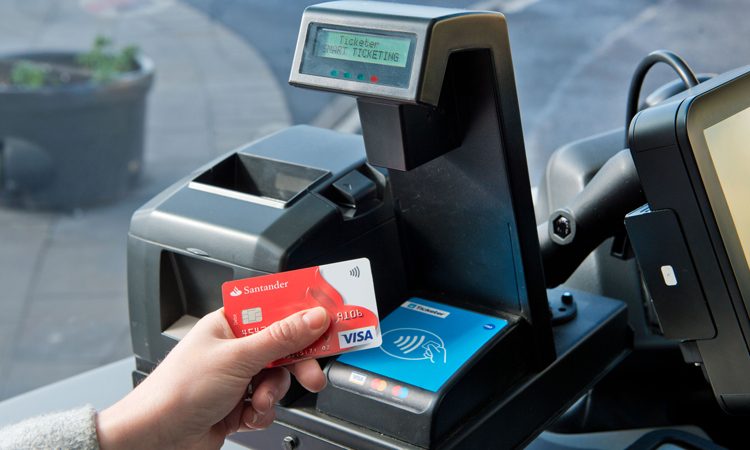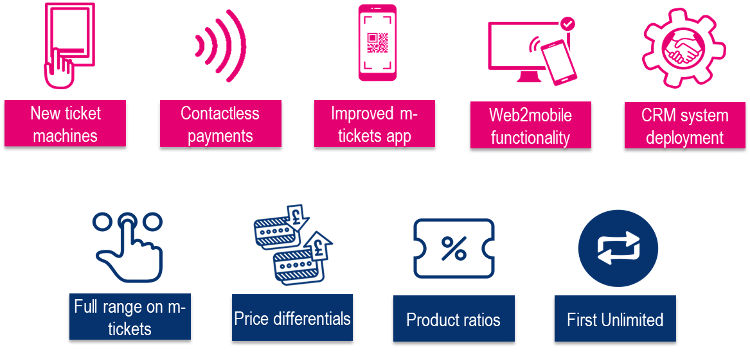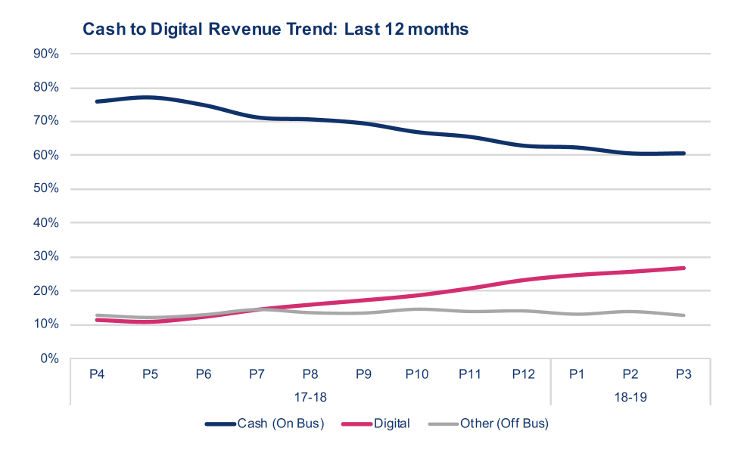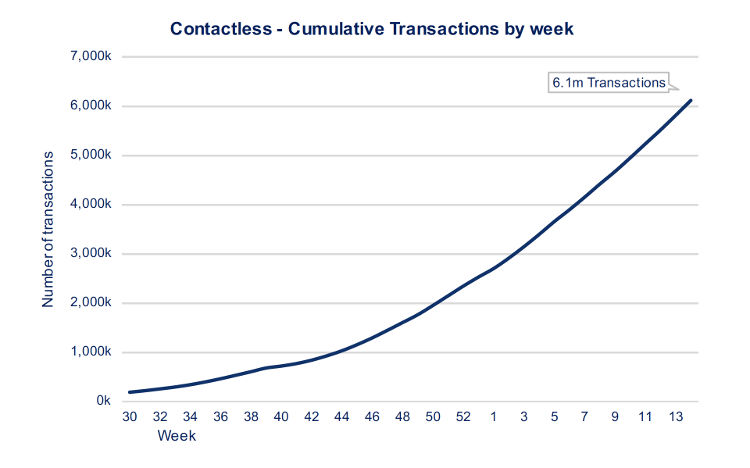Driving strategy change with a customer-centric approach to ticketing
- Like
- Digg
- Del
- Tumblr
- VKontakte
- Buffer
- Love This
- Odnoklassniki
- Meneame
- Blogger
- Amazon
- Yahoo Mail
- Gmail
- AOL
- Newsvine
- HackerNews
- Evernote
- MySpace
- Mail.ru
- Viadeo
- Line
- Comments
- Yummly
- SMS
- Viber
- Telegram
- Subscribe
- Skype
- Facebook Messenger
- Kakao
- LiveJournal
- Yammer
- Edgar
- Fintel
- Mix
- Instapaper
- Copy Link
Posted: 21 September 2018 | Dave Lynch (Group CIO - FirstGroup) | No comments yet
Dave Lynch, Group CIO at FirstGroup PLC, explains how the digitalisation of the First Bus Division is not only transforming the customer experience, but also helping address day-to-day operational challenges.


At FirstGroup, we are driving change across all our divisions by challenging our normal operating methods and placing technology at the heart of the transformation. Our bus division has made huge strides in the last 18 months with a programme that revolves around the customer being at the heart of the business.
Putting the customer at the centre of our strategy has enabled us to identify the areas we need to invest in to continuously improve our services and encourage more people to travel using the bus. Ultimately the customer experience is the key to driving growth, but efficiencies within our operations are also a critical part of our business; they help to provide a more reliable service and an easier way to understand our customers’ unique proposition.
Technology is mostly driving the change, but we have seen that without human application, technology alone would not cause a significant enough impact.
Therefore, we are striving to make things better for the customer by:
- Making it simple
- Speeding up our buses and reducing journey time
- Using data to make insightful decisions
- Developing a customer relationship as opposed to a transactional one.
At the same time, these focuses drive operational change, creating a symbiotic relationship between benefits for the customer, and for the company.


By promoting our digital offering to both customers and staff – alongside some hardware and system changes – we are delivering improvements. Making the day job easier for our staff allows them to focus on being a ‘Journey Maker’ and providing excellent customer service.
In addition, we are giving our staff better information and tools to ensure the customer experience is increasingly seamless. Improving journey times and freeing resources to serve other sections of our network leads to a much-improved customer offering.
The digitalisation of these elements has allowed us to forensically measure the improvements and outcomes, allowing for continuous improvement and the shift of our core business focus from providing services for our existing customers, to looking at growth opportunities.
Retail strategy – cash off bus
Our retail strategy is focused on developing two main channels, mTickets and contactless, while serving our customers with a subscription-style ticket product. We decided on these channels as they enable us to migrate customers and deliver operational efficiencies, whilst at the same time providing them with additional information when riding the bus.
At the start of our implementation, approximately 77 per cent of our commercial revenue across the bus division was cash on the vehicle. We have set ourselves an ambitious target of turning that around and achieving 80 per cent of our commercial revenue through a digital channel within the next three years.
To achieve this, we have replaced the on-bus ticketing hardware to enable the ability to read and record different forms of tickets – over the last 12 months we have replaced over 5,000 ticket machines on our vehicles. These new machines, provided by Ticketer, critically have a mobile SIM connection that allows us to receive information about both bus position and revenue in near-real time. This, alongside the functionality to accept ITSO smartcards, barcode scanners and EMV contactless readers, has enabled us to significantly alter the customers’ ticketing proposition.


More than 30 per cent of payments are now made by contactless in some operating companies and mobile ticket revenue was up over 100 per cent in 2017
By having two distinct avenues through which our customers can engage with us, our early iterations of contactless technology are giving our more ad-hoc and infrequent users the ability to turn up and buy a ticket. They no longer have to worry about having the correct fare or even knowledge of the fare system before they board. Conversely, our more regular users have access to a full product set through mTickets that includes longer term season tickets which provide better value for regulars. Ultimately, we would like customers to move towards a subscription product that enables them to pay monthly and not worry about their need to travel.
The transition of our customers has been driven by price differentiation, messaging to staff and information for customers. Interestingly, the influences of area and implementation approach have seen some significant differences in the way people adopt these changes, but universally, the uptake has been both significant and positive.
The technology innovations introduced are driving the channel shift to achieve our 80 per cent target. As a division, we have achieved a movement of 15 per cent of our cash payments to a digital channel over the last year and we now have a total of 27 per cent of our revenue through digital channels. Over 30 per cent of payments are now made by contactless in some operating companies (£24 million cumulatively since June 2017) and mobile ticket revenue was up over 100 per cent in 2017 (£72 million) versus the prior year (and continues at more than 65 per cent year-on-year in 2018). We continue to be ambitious, with targets to almost double mTickets revenue to £140 million for the 2018-2019 full year and for contactless payments to reach 30 per cent of on-bus revenue across all operating companies.
We have recently passed the 6 million contactless transactions mark and are seeing over 300,000 transactions a week, with continued rapid growth at a pace ahead of our expectations.
Combined with the fact we had over 450,000 unique users of our mobile apps in the last month [correct at time of writing] either purchasing tickets or using the real-time and journey planning services, we are seeing real behavioural change amongst our customers.


FirstGroup sees 300,000 contactless transactions every week, and has now hit 6 million overall
Our drivers have embraced the change as it has simplified their role, meaning they can handle large numbers of customers quickly and simply with a reduced need to handle cash. Digitalisation has also allowed real-time communications between depots and drivers through the ticket machine.
Overall, the introduction of the technology has seen an increase in customer satisfaction and driver engagement, as well as improved performance and more accurate data. The reduced dwell time has also significantly contributed to a more reliable and environmentally-friendly service.
We’re incredibly excited about the opportunities and benefits that cashless ticketing affords to not just our business, but to our customers and the environment too. We’re confident that through digital-based innovations like our app, real-time information and cashless ticketing, we will grow our business and place First Bus alongside other established customer-focused retailers.
Our staff
One of the most important investments any organisation can make is in its staff and I’m proud that as part of my role I can bring about fundamental change that makes the lives of our staff easier and more effective. This obviously benefits our customers as well, which reinforces why I see this as a major part of my day-to-day role.
We have invested in a new app for our staff that allows them to keep up to date with the latest news and information on the business, receive training, useful hints and tips, access their pay slips and duty rosters and, in the future, will allow them to carry out many of the traditional HR functions that are currently handled at the depot. By doing this we can more directly connect our drivers to our customer feedback – our ‘Tell First Bus’ function can be made directly available to our staff so they can understand the thoughts and frustrations of some of our customers. This has already led to great ideas about how we can try to improve the experience by making things better for our staff.
We will become the number one bus operator in the country and the continued focus and investment in our driver training, innovative technology and operational processes will enable us to achieve this.
Necessary innovation
I do not like innovation for innovation’s sake – currently I see a trend within the industry to run numerous pilots of different technologies without these translating into business change. We have been very disciplined and brought a laser-like focus to our core technologies within the business, ensuring that we have maximised, and continue to maximise, the potential of what we have brought to market. We are using customer adoption and transition from existing methods as our key success metric, alongside ensuring that we have generated a return on our investment. We continue to push this message as it is how we will elicit real change; it is testament to the team and the progress we have made so far.
However, the digital world is moving quickly and we would be remiss not to keep track of new developments and modifications that we can make. Our constant investment in our mobile products is a case in point; through our relationship with our partners Future Platforms and Corethree, we continue to modernise and develop the mobile products bringing new payment mechanisms and up-to-date customer features to the market.
Further to this, we are actively looking at where the technology will take us in the future. Location services technology is something that I think will start to have a significant role moving forward. Through using beacons on a vehicle or location services within a phone, we can provide relevant information to customers when they are on the move. This can include live service disruption data, notifications when to prepare to depart from a bus, or even prompts to access and present tickets. These are ways to simplify the use of public transport and consequently drive growth. In the future there is the ability to evolve these functions to mirror our contactless account-based travel where we charge people for the journeys that they make.
Another area where I see great utilisation is in the use of ‘bots’, particularly for customer services. With the growing proliferation of voice-activated products, bots will have a key role in providing answers and services to our customers quickly and naturally. The ability to check when your next bus is, buy your regular ticket again and have it appear in your mobile app by interacting with Alexa or Siri, will make customers’ lives easier.
These trends are important we are actively investing in them. With this said, the industry needs to ensure we listen to our customers and our staff on the ground to make sure we deliver the change in play now. Doing what we say we will do is what will truly transform our business and continue to make a success of our services.
Related topics
Passenger Experience, Ticketing & Payments
Issue
Issue 3 2018
Related modes
Bus & Coach
Related cities
UK
Related organisations
First Group








